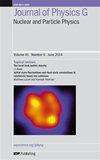Quark-antiquark states of the lightest scalar mesons within the Nambu-Jona-Lasinio model with flavor-dependent coupling constants
IF 3.5
3区 物理与天体物理
Q2 PHYSICS, NUCLEAR
Journal of Physics G: Nuclear and Particle Physics
Pub Date : 2022-12-13
DOI:10.1088/1361-6471/acdaea
引用次数: 2
Abstract
The quark-antiquark components of the U(3) lightest scalar meson nonet are investigated by considering the Nambu-Jona-Lasinio model with flavor-dependent coupling constants that were derived by considering (non-perturbative) gluon exchange. The strange quark effective mass ($M_s^*$) is varied such that the strangeness content of these scalar mesons can be analyzed further. The neutral states $S_0$, $S_8$ and $S_3$, are adopted as the most relevant quark-antiquark components respectively of the $\sigma(500)$, $f_0(980)$ and $A_0^0(980)$ mesons. As a result, the mass hierarchy between states $S_0$ and $S_8$, and $K^*_0(700) - A_0(980)$ mesons, can be respectively inverted and corrected for quite low values of the strange quark constituent mass. Besides that, for some particular values of $M_s^*$, the masses of $\sigma(500)$ and $f_0(980)$ can also be obtained by considering the mixing coupling constant $G_{08}$. However, the masses of all the nine mesons are not described simultaneously in a self-consistent procedure, and this goes along with the need of non-quark-antiquark states to completely describe their masses. A neutral-meson mixing matrix is defined and the leading mixing angle is found by fitting a correct value of the $\sigma (500) -f_0 (980)$ mass difference. Two different estimates for the strengths of the mixings $A_0^0 \to f_0$ and $f_0 \to A_0^0$ are proposed, leading to somewhat different behaviors. Firstly, by assuming leading transitions to intermediary flavor eigenstates and secondly by considering a dynamical evolution. Results may be in good agreement with experimental values from BESS-III depending on the value of the strange quark effective mass.具有风味依赖耦合常数的Nambu-Jona-Lasinio模型中最轻标量介子的夸克-反夸克态
通过考虑(非微扰)胶子交换导出的具有香味依赖耦合常数的Nambu-Jona-Lasinio模型,研究了U(3)最轻标量介子nonet的夸克-反夸克分量。奇异夸克有效质量($M_s^*$)的变化使得这些标量介子的奇异性含量可以进一步分析。采用中性态S_0$、S_8$和S_3$分别作为$\sigma(500)$、$f_0(980)$和$A_0^0(980)$介子最相关的夸克-反夸克分量。因此,在奇异夸克组成质量相当低的情况下,可以分别对状态$S_0$和$S_8$以及$K^*_0(700) - A_0(980)$介子之间的质量层次进行反转和校正。此外,考虑混合耦合常数G_{08}$,对于某些特定的$M_s^*$,也可以得到$\sigma(500)$和$f_0(980)$的质量。然而,所有九个介子的质量并不是在一个自洽的过程中同时描述的,这与需要非夸克-反夸克状态来完全描述它们的质量是一致的。定义了一个中性介子混合矩阵,并通过拟合正确的$\sigma (500) -f_0(980)$质量差值找到了先导混合角。对混合$A_0^0 \到f_0$和$f_0 \到A_0^0$的强度提出了两种不同的估计,导致了一些不同的行为。首先,通过假设主要过渡到中间风味特征态,其次考虑动态演化。结果可能与BESS-III的实验值很好地吻合,这取决于奇异夸克有效质量的值。
本文章由计算机程序翻译,如有差异,请以英文原文为准。
求助全文
约1分钟内获得全文
求助全文
来源期刊
CiteScore
7.60
自引率
5.70%
发文量
105
审稿时长
1 months
期刊介绍:
Journal of Physics G: Nuclear and Particle Physics (JPhysG) publishes articles on theoretical and experimental topics in all areas of nuclear and particle physics, including nuclear and particle astrophysics. The journal welcomes submissions from any interface area between these fields.
All aspects of fundamental nuclear physics research, including:
nuclear forces and few-body systems;
nuclear structure and nuclear reactions;
rare decays and fundamental symmetries;
hadronic physics, lattice QCD;
heavy-ion physics;
hot and dense matter, QCD phase diagram.
All aspects of elementary particle physics research, including:
high-energy particle physics;
neutrino physics;
phenomenology and theory;
beyond standard model physics;
electroweak interactions;
fundamental symmetries.
All aspects of nuclear and particle astrophysics including:
nuclear physics of stars and stellar explosions;
nucleosynthesis;
nuclear equation of state;
astrophysical neutrino physics;
cosmic rays;
dark matter.
JPhysG publishes a variety of article types for the community. As well as high-quality research papers, this includes our prestigious topical review series, focus issues, and the rapid publication of letters.

 求助内容:
求助内容: 应助结果提醒方式:
应助结果提醒方式:


